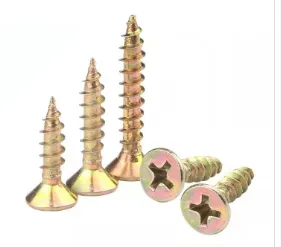High Strength Hex Bolts: Robust Assurance for Industrial Heavy Duty Connections
Aug . 13, 2025 11:39 ତାଲିକାକୁ ଫେରନ୍ତୁ |
High Strength Hex Bolts: Robust Assurance for Industrial Heavy Duty Connections
In the heavy-duty connection scenario of the industrial field, High Strength Hex Bolts have become a "sturdy link" to ensure the safe operation of large equipment and heavy structures with their load-bearing capacity and stability performance far exceeding ordinary bolts. Their role in key fields such as mechanical manufacturing and construction engineering is irreplaceable.

The High Strength Hex Bolts continue the classic hexagonal head shape in structural design, making it easier for wrenches to apply greater torque, while also strengthening and upgrading details
The thread accuracy of the ହେକ୍ସ ବୋଲ୍ଟ | screw section is higher, and the tooth profile angle has been optimized to form a tighter mesh during the tightening process, effectively dispersing the load. The transition part between the bolt head and the screw adopts a circular arc transition design to reduce stress concentration and avoid fracture when subjected to high-strength loads. This precise structural treatment enables it to adapt to long-term high-intensity working environments.
The selection of materials is the core of achieving high performance with High Strength Hex Bolts
These types of bolts are mostly made of high-strength alloy structural steel, such as 40Cr, 35CrMo, etc. After quenching and tempering heat treatment, their tensile strength can reach over 800MPa, far exceeding the 300400MPa of ordinary bolts. In some special scenarios, stainless steel or titanium alloy materials may also be used to ensure high strength while possessing excellent corrosion resistance, meeting the requirements of harsh environments such as chemical and marine engineering.
The application of High Strength Hex Bolts in the heavy-duty field is extensive and critical
In the manufacturing of large mechanical equipment, plain hex bolts are used to connect core components such as machine tool beds and engine cylinder blocks, ensuring that the equipment does not loosen during high-speed operation and heavy load conditions; In civil engineering such as bridges and high-rise buildings, as the main connecting component of steel structures, it plays an important role in transmitting loads and stabilizing the structure; In new energy equipment such as wind turbines and nuclear power plants, their reliable strength ensures the long-term safe operation of large equipment.
With the development of industrial technology, the performance of High Strength Hex Bolts continues to break through
The surface treatment technology is becoming increasingly advanced, and through processes such as zinc infiltration and Dacromet, its corrosion resistance and wear resistance are further enhanced; The precision control of bolts is stricter, and the tolerance range of threads is reduced to micrometer level, ensuring the consistency and stability of the connection; At the same time, the anti loosening technology continues to innovate, using methods such as thread tightening and pre coating glue, effectively solving the problem of loosening in vibration and impact environments, and extending maintenance cycles.
In summary, High Strength Hex Bolts have become an indispensable core component in industrial heavy-duty connections due to their reinforced structural design, high-quality material selection, key applications in the heavy-duty field, and continuous technological upgrades. It provides a solid guarantee for the safe and stable operation of various large equipment and heavy structures with its high strength and reliability. In the future, with the continuous improvement of connection performance requirements in the industrial field, High Strength Hex Bolts will continue to innovate in materials, processes, and functions, injecting stronger connection power into industrial development.
High Strength Hex Bolts FAQs
How to distinguish the strength level of High Strength Hex Bolts?
High Strength Hex Bolts are typically classified based on material properties, such as 8.8, 10.9, 12.9 in ISO standards, or SAE J429 in American standards (such as Grade 5, Grade 8). The larger the number, the higher the tensile strength and yield strength.
What materials are commonly used for High Strength Hex Bolts?
Common materials include medium carbon steel, alloy steel (such as 35CrMo, 42CrMo), or boron steel, which require quenching and tempering heat treatment (quenching+tempering) to achieve high strength performance. Some special environments may use stainless steel (such as A270, A480).
What are the advantages of High Strength Hex Bolts compared to regular bolts?
Higher tensile strength and fatigue resistance;
Suitable for heavy-duty, vibration or impact environments (such as bridges, building steel structures);
Usually requires torque control tightening to provide more stable preload force.
What should be noted when installing High Strength Hex Bolts?
Pre tightening torque must be applied according to design requirements (refer to torque table or direct tension method);
Do not reuse (some grades of bolts are installed in one go);
The contact surface needs to be cleaned to avoid oil stains or rust affecting the friction coefficient.
How to distinguish the authenticity or quality of High Strength Hex Bolts?
Check the strength markings on the bolt head (such as 8.8, 10.9, etc.);
Testing tensile strength, hardness and other indicators through third-party testing;
Observe whether the surface treatment (such as Dacromet, hot-dip galvanizing) is uniform, without cracks or burrs.
ତାଜା ଖବର
-
Bolts for Lawn Mower Handle Supplier | OEM & Rust-Resistant
ସମ୍ବାଦNov.17,2025
-
Silver Screws Supplier | Corrosion-Resistant, Bulk & Custom
ସମ୍ବାଦNov.17,2025
-
Cabinet Bolts Supplier | OEM, Bulk Stock, Fast Shipping
ସମ୍ବାଦNov.17,2025
-
Axle Nuts Supplier - OEM-Grade, ISO-Certified, Fast Delivery
ସମ୍ବାଦNov.17,2025
-
Wire Bolts Suppliers – OEM Factory Prices, ISO Quality
ସମ୍ବାଦNov.11,2025
-
Bolts for Lawn Mower Handle Supplier – OEM & Anti‑Rust
ସମ୍ବାଦNov.11,2025
